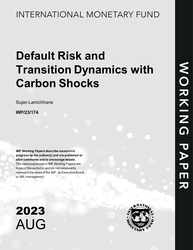
Default Risk and Transition Dynamics with Carbon Shocks
Default Risk and Transition Dynamics with Carbon Shocks
READ MORE...
Volume/Issue:
Volume 2023
Issue 174
Publication date: August 2023
ISBN: 9798400252440
$20.00
Add to Cart by clicking price of the language and format you'd like to purchase
Available Languages and Formats
| English |
Prices in red indicate formats that are not yet available but are forthcoming.
Topics covered in this book
This title contains information about the following subjects.
Click on a subject if you would like to see other titles with the same subjects.
Exports and Imports , Economics- Macroeconomics , Economics / General , Industries - Manufacturing , Environmental Economics , Environmental Conservation and Protection , Default risk , climate risk , carbon price , transition dynamics , cost of capital , risk premium , , climate mitigation policy , carbon price shock , policy shock , price shock , default rate , Debt default , Greenhouse gas emissions , Manufacturing , Global
Summary
Climate mitigation policies are being introduced around the world to limit global warming, generating new risks to the economy. This paper develops a continuous time heterogeneous agents model to study the impact of carbon pricing policy shocks on corporate default risk and the consequent transition dynamics. We derive a closed-form solution to corporate default probability based on firms' intertemporal optimization decisions and explicitly characterize the transition speed. This allows for studying policy implications in an analytically tractable way. The model is calibrated to different US corporate sectors to quantify the heterogeneous effects of carbon price shocks. While carbon-intensive sectors face increased default risks, there are notable asymmetric effects within sectors. Higher carbon prices increase default risk but also induce faster transition towards the new post-shock steady state with a highly non-linear impact. Our results suggest that once a range of possible price shocks are accounted for, the increase in the cost of capital/risk premiums might be sharply different across sectors.
Copyright © 2010 - 2025
Powered by:
AIDC



